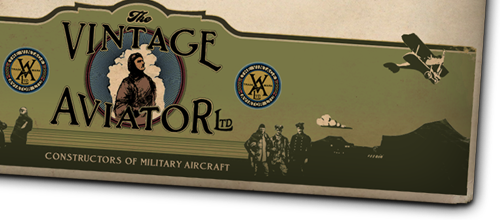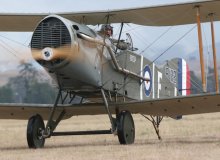You are here
F2B History
"Originally designed as a reconaissance aircraft, the F2B went on to become the most successful and deadly British two-seater fighters of the first world war and was affectionately referred to as the 'Brisfit' or the 'Biff'."
Overcoming a disastrous start to its career during Bloody April, the F2B proved itself as a stable and highly maneuverable fighter, light bomber and spotter and remained in military service into the 1930s. Surplus aircraft became popular for civil aviation also.
Design and Modifications.
Initial designs by Capt. Frank Barnwell in 1916 were intended to replace the BE2 series and to serve in the same class as the RE8 and FK8. First flown in September, 1916 and entering service in 1917, the first model was the F2A or Type 12 which was assigned to 48 Squadron RFC. Only around 52 of these models were ever produced until the definitive Bristol Fighter or F2B emerged through lessons learned with the initial service of the F2A and a series of modifications began, one of the most important being the powerplant. The fuselage was altered to improve the pilot and gunner's view as well as larger tail surfaces, increased fuel supply, larger capacity for ammunition and the welcome addition of the Rolls Royce Falcon Engine.
The first of the F2As were fitted with a 190hp Rolls Royce Falcon I which was replaced by the 220hp Falcon II and later the powerful 275hp Falcon III which enabled the aircraft to reach speeds of 123 mph. Due to the short supply of Rolls Royce aero engines of all types during this period, plans to incorporate the F2A and later the F2B as the standard two-seater stalled and efforts to find other engines powerful and reliable enough to complement the aircraft were met with frustration.
The 200hp Sunbeam Arab was used and developed but suffered terrible vibrations and was not popular. Other engines fitted to the F2B without complete success included the 200hp RAF 4d, the 180hp Wolseley Viper and the 230hp Armstrong Siddeley Puma. Armament for the F2A and the F2B started with a fixed, forward firing synchronized .303 Vickers machine gun and one (later two) flexible Lewis machine guns mounted in the observer's cockpit on a scarf ring. Bombs were also added to the aircraft and included 112 pounders or a 240 pound bomb.
Service.
The F2As flew to France in March, 1917 and began their first offensive patrol on April 5th which resulted in disaster and almost ended their production. Six of No. 48's Bristol F2As, led by Capt. W. Leefe Robinson V.C, were sent to patrol over Etouai where they were ambushed by five Albatros D IIIs led by Manfred von Richtofen. Unaware of the F2A's fine maneuverability, Robinson and his men attempted to hold flight formation and use their rear gunners as defense (which was standard practice at the time for two-seater aircraft in formation) All but two of the F2As were destroyed. Richtofen noted in his combat report that the Bristol appeared "to be quick and handy" but summarised that the Albatros DIII was superior in speed and ability.
This disastrous loss to the RFC could have ended the Bristol's career then and there as other fighter craft were beginning to be developed. But after several more missions the Bristol pilots soon learned of the aircrafts strength and agility and discovered that it was most effective when fought as a single-seater with the observer left to protect the tail. As pilots gained confidence with the Bristol it began to earn itself a reputation as a dangerous foe and was treated with great respect by its enemies. With the pilot and the observer placed so close together, communication was easy and instant and an amazing pitch of fighting efficiency was garnered by Bristol crews who were known for never refusing battle. It was later noted by these crews that it was difficult to 'get into a scrap' with the enemy unless flying in pairs or singly.
Service experience with the F2A soon led to pilots asking for improvements such as an increased field of vision for the pilot, so the fuel tank and cowling were narrowed by sloping the upper longerons downwards in front of the observer's cockpit. With this revised fuselage the first prototype was designated A.3304 and further modified aircraft numbered A.7101 and onwards became the famous F2B. With the unfortunate shortage of Rolls Royce engines in 1918, most of the modifications to the F2B were to incorporate a suitable powerplant. Various patterns of exhaust pipes were used, those on the Falcon powered machines varied considerably in length and shape. The unpopular Sunbeam Arab had stubs or pipes, the Puma (which was similar to the DH9) had a huge single exhaust pipe on the port side and only a few of the experimental F2Bs gave host to the 200hp RAF 4d.
By the time of the armistice, the Bristol had shot down over 148 enemy aircraft including, Albatros DIIIs, Fokkers, Pfalz Scouts and Gothas. One of the most notable F2B pilots was New Zealander Keith Park who later became Air Vice Marshal during WWII and commanded No. 11 Group RAF which was responsible for the fighter defence of London and southeast England and is largely regarded as leading England to victory during the Battle of Britain. Park joined 48 Squadron in France in 1917 and was credited with shooting down around 20 enemy aircraft, one of them killing Lt. Franz Pernet of Jasta Boelcke who was a stepson of General Erich Ludendorff. Park was also shot down twice during this period.
Service beyond WWI.
Despite its various engine problems, the Bristol enjoyed a remarkable service career that extended beyond the first air war. After WWI, the Bristol was used for army co-operation duties and served on the North-West frontier of India until it was replaced by the Westland Wapiti. It was also used for policing in Iraq during the 1920s.
Modifications after the war produced the MK II and MK III versions and further aerodynamic experiments with wings of different aspect ratios, aerofoil sections and most importantly, Handley Page slots gave the Bristol a new lease of life and prolonged its service career. After July, 1928, all RAF Bristols which were due for reconditioning were converted to MK IVs with the fitting of slots, long-travel under-carriages and balanced rudders. Eventually, they were supplied to University Air Squadrons and finally regarded as obsolete in 1931. From there the Bristol was available for sale to the public and was used for demonstrations, towing advertisement banners, flight training, tours and even as camera craft for film production companies.
With their excellent war-time record, the Bristol was used by many other countries for military and civilian duties. It traveled as far as New Zealand and the United States (where different models were produced by various companies) and was used by the Polish Air Force, Sweden, Greece, Spain, Ireland, Norway and even New Guinea.
Specifications (F2B):
Wingspan: 39 ft
Length: 25 ft
Height: 9 ft 9 in
Empty Weight: 2,145 pounds
Maximum Weight: 3,243 pounds
Powerplant: Single 275hp Rolls Royce III Falcon
Liquid-cooled V12 (other engines also used)
Armament: 1 x .303 Vickers machine gun.
2 x .303 Lewis machine guns
1 x 240 pound bombs
Performance:
Maximum Speed: 123 mph
Service Ceiling: 18,000 ft
Range: 369 miles




